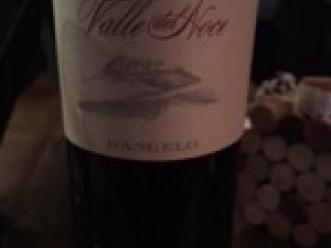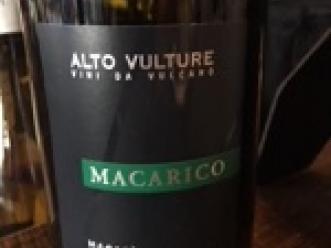All the way down at the southern end of Italy, in the arch of the boot, is the region of Basilicata. It is sparsely populated with sturdy peoples of very old traditions. The people who reside there often call their region by the ancient Roman name of Lucanta. The wine making and drinking traditions there predate Rome. One of the oldest and best wines made there is from the Aglianico grape. It is called Aglianico del Vulture. In fact, it is one of the great-undiscovered wines of Italy. This is most likely due to the isolated position of Basilicata and lack of tourism.
Basilicata is a poor region. The area, being mostly mountainous is not well suited to agriculture. The climate is often dry. Despite being in the south, the locale has lots of mountains and hills and can be surprisingly cool. It has lagged behind most of Italy’s industrialization.
It is known that the Aglianico grape has been grown in Basilicata since the 6th century BC. There are three theories about its origin; two of them crediting the ancient Greeks with its introduction to Italy. One theory purports that the Greeks planted the grape in their colony of Metaponto on the Basilicata coast where the grape was called ellenico, the Italian word for Hellenic or Greek. Another theory has the Greeks first planting Aglianico in Campania, just north of Naples, and used to make Falernum, a red wine hailed by the Roman writers of that time as one of the best in Rome. A third more recent theory has the Aglianico grape being native to southern Italy. Attilio Scienza of the University of Milan claims the grape grew wild and was enjoyed as early as the Bronze Age by the indigenous peoples. According to Scienza, the Greeks discovered it there and named is eilanikos, which means a vine that grows up trees. While the authentic truth may never be know, I suspect some amount of regional and/or national pride is behind many of these theories. Until the DNA evidence can track it down for sure, feel free to choose whichever version suits you best.
Although Aglianico wine is made throughout much of central and southern Italy, the version in Basilicata is unique and worth tracking down. The best wines are made from grapes grown on Monte Vulture, an extinct volcano in northwest Basilicata. Monte Vulture is 4,350 feet high and has rich volcanic soils. The vineyards are as high as 2400 feet although the better ones seem to be at 600 to 1800 feet. Most of the vineyards are concentrated on the eastern face of the mountain. The climate is actually rather cool on the mountain. The harvests are some of the latest in Italy usually beginning around October 20th or even afterward. This longer, cooler growing season allows the grapes to develop not only physically, but also in great balance and complexity.
Basilicata’s Aglianico del Vulture DOC was created in 1971 and require the wine to be made from 100% Aglianico grapes. The dry table wines come in three types: the regular version is aged for 12 months, the Vecchio is aged for 36 months, and the Riserva which is aged for 60 months before being released. There are also sparkling versions made, both dry and sweet, which must be aged for 12 months. I have never seen a sparkling version here in the states and the wines I recommend are the dry better table versions.
Aglianico wine is deeply colored purple and blue. It has huge aromatic notes of blackberries, coffee, leather and smoke. Aglianico del Vulture wines are full bodied with plenty of fruit and tannins in their youth. They are capable of ageing for a long time, the best of them can easily last 15 or 20 years in a good cellar. With age, these wines develop plenty of complex layering and nuances.
Vintages do matter here, but not nearly as much as producer. It is very difficult to get good vintage information without trying the wines and making a personal decision. In my opinion, 1997, 2000, and 2001 represent some of the best recent vintages that you are likely to encounter. The best of these wines (Vecchio or Riservas) should be aged for at least a few years and can hold up well for ten or 15 years in a cellar and probably longer. Due to their high level of tannins, it is sometimes difficult to drink these more profound wines in their youth. Even when opening the regular younger versions, I would recommend decanting for a few hours.
Perhaps due to Basilicata’s isolation, the wine industry has changed little from the 1920s to the 1980s. The two largest and best know wineries of Basilicata, Paternoster and D’Angelo, both first opened in the 1920’s. These two established producers make very good wines incorporating the modern techniques of winemaking that have swept thru the rest of Italy. Paternoster makes three wines of note. Their Synthesi bottling is available for $20 or less and is very good. Their Rotondo is a step up at $50 bottle and is modern in style and shows a bit of oak. Their Don Anselmo, also around $50, is even better, it is a spectacular bottle of wine that will age gracefully for a long time in the cellar. D’Angelo is probably the largest producer in the Basilicata. They make a nice entry level wine labeled as Aglianico del Vulture. Their Donato D'Angelo wines is a step up from that. They also make a D’Angelo Riserva for about the same price as the Donato. Their best bottling may be the Valle del Noce. In addition, they make a very good IGT wine called Canneto.
There are still very few wineries producing wine in Basilicata and even less exporting them. In the last 20 years or so, new life has been breathed into the area. There are many smaller producers coming on line and even a few large ones making good to great wines. My suggestion is that if you see a bottle and the price seems reasonable, try it. One producer that I have enjoyed, whose Aglianico del Vulture is available for around $30 is Re Manfredi. Other wineries on my list include Basilisco, Elena Fucci, Notaio, Tenuta La Querce, and Terra Dei Re. You can find entry-level offerings for around $10. The best wines will cost around $60. Either way, these are often exceptional buys for the quality in the bottle.
The biggest issue when matching these wines with food is the age of the wine. I am always a proponent of trying to emulate the local cuisine with the local wines when in doubt for food pairings. Younger wines work well with pasta. In Basilicata the local pasta is called lugane. Aged Aglianico del Vulture wines fare better with lamb and cheeses. In Basilicata, the locals seem to prefer spicing up their dishes with the local hot pepper known as diavolicchio. Other dishes that go well include hare, beef and eggplant.
Aglianico del Vulture can be a serious wine to cellar for years or a wine to buy and enjoy with dinner. As consumers we are able to take advantage of its undiscovered status among the worlds really great wines. I hope you all try a bottle or two and let me know what you think.
Loren Sonkin is an IntoWine.com Featured Contributor and the Founder/Winemaker at Sonkin Cellars.



